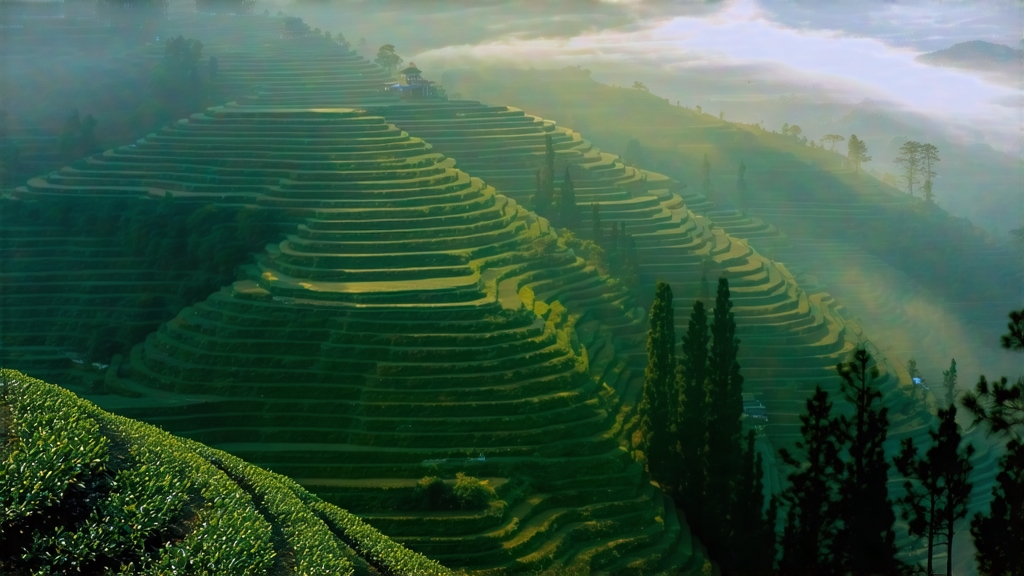
Long before Assam, Ceylon, or Earl Grey ever reached European cups, the first fully oxidized leaf humanity tasted came from a narrow, mist-locked canyon in China’s Wuyi range. Locals simply called it “xiao zhong”—“small cultivar”—but the trading posts of Xiamen labeled the crates “Lapsang Souchong,” a rough Cantonese-Portuguese hybrid that meant “small sort from Lapu mountain.” Whatever the etymology, the tea that sailed out of 17th-century Amoy harbor was so dark, so aromatic, and so unlike anything the West had drunk that the English coined a new word for it: black tea. In China we still say “red tea,” hong cha, for the copper-amber color of its infusion, yet the global story of black tea begins here, with a leaf gently withered over smoldering pine.
History: From Bandit Hideout to London Drawing Rooms
The Wuyi’s vertical cliffs and rock-stair terraces have sheltered tea since the Song dynasty, but Lapsang Souchong’s documented birth sits in the chaotic late Ming. Legend blames an army unit passing through Tongmu village who commandeered tea sheds for the night. By morning the green leaves had oxidized; to salvage the crop, farmers rushed the oxidation over open pine fires. The accidental smoke married with the natural malt sugar of the leaf, and the resulting tea—shipped through Dutch and later British East India merchants—ignited a craze that would redraw world maps. By 1662 Catherine of Braganza’s dowry chest included a tin of Lapsang; Samuel Pepys wrote of tasting “a kind of Chinese drink called tee, very smoky and fragrant.” Two centuries later the same craving drove Scottish botanist Robert Fortune to smuggle tea plants and Wuyi craftsmen into India, hoping to replicate the flavor. They never quite succeeded; the pine terroir of Tongmu remains unreproducible.
Micro-Terroir: One Canyon, Two Rivers, Three Aromas
Tongmu lies inside a national reserve where Fujian’s moist monsoon collides with cool Jiangxi air, creating 200 foggy days a year. The canyon is only seven kilometers long, drained by the Tongmu and Longchuan streams whose granite beds leach low-alkaline, mineral-rich water. Day-night temperature swings of 15 °C slow leaf growth, concentrating aromatic oils. Indigenous cultivars—Xingcun Xiaoye, Wuyi Qizhong, and the rare wild Caicha—have evolved thick cell walls that withstand pine-fire roasting without collapsing into bitterness. Within this micro-zone the Chinese government has drawn a core origin circle of barely 600 hectares; any leaf picked outside it may be called “smoked black tea,” but never “Zheng Shan Xiao Zhong,” the protected name for authentic Lapsang Souchong.
Harvest Calendar: Qingming to Guyu
Plucking begins around April 5, the Qingming festival, when buds have opened into one leaf and a half. The highest grade, Jinzhen (Golden Needle), keeps only the unopened bud, downy and pale gold. Second grade, Chigan (Crimson Stem), retains one leaf and the tender stem, prized for its honeyed finish. After Guyu (April 20) the rains arrive; leaves fatten and lose fragrance, so picking stops. A skilled picker harvests barely four kilograms of fresh leaf per day—enough, after processing, for just 800 g of finished tea.
Craft: Eight Steps, One Mistake, No Second Chance
- Withering: Fresh leaves are spread 3 cm deep on bamboo trays set inside semi-subterranean withering huts. Pine logs smolder in a fire-pit below; warm smoke (35 °C) rises through slatted floors, curling around the leaf for 8–10 hours until it loses 60 % moisture and smells like candied apricot.
- Rolling: Once limp, the leaf is hand-rolled on rattan mats, rupturing cells to release catechins and polyphenol oxidase.
- Oxidation: The rolled leaf is piled in pine-wood boxes covered with wet cloths. For three hours enzymes transform green chlorophyll into theaflavins and thearubigins; the leaf turns from jade